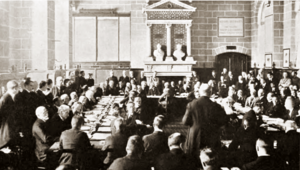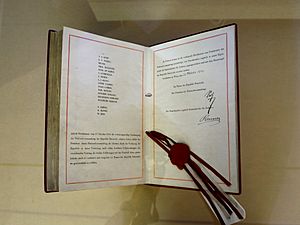Treaty of Saint-Germain-en-Laye (1919) facts for kids
| Treaty of Peace between the Allied and Associated Powers and Austria | |
|---|---|

Austrian chancellor Renner addressing the delegates during the signing ceremony
|
|
| Signed | 10 September 1919 |
| Location | Château de Saint-Germain-en-Laye, Île-de-France, France |
| Effective | 16 July 1920 |
| Condition | Ratification by Austria and four Principal Allied Powers |
| Parties | |
| Depositary | French Government |
| Languages | French, English, Italian |
The Treaty of Saint-Germain-en-Laye (which in French is Traité de Saint-Germain-en-Laye) was an important peace agreement. It was signed on 10 September 1919. The treaty was made between the winning countries of World War I, called the Allied Powers, and the country of Austria.
This treaty was similar to others signed after World War I, like the Treaty of Trianon with Hungary and the Treaty of Versailles with Germany. It included the rules for the League of Nations, which was an organization created to help keep peace in the world. Because of this, the United States did not officially approve the treaty. Instead, they signed their own peace treaty with Austria in 1921. The signing ceremony took place at the beautiful Château de Saint-Germain-en-Laye in France.
Contents
Why Was This Treaty Needed?
After World War I ended in 1918, the old Austro-Hungarian Empire fell apart. This empire was a large country made up of many different groups of people. On 21 October 1918, German-speaking leaders from the Austrian part of the empire met. They formed a temporary government for "German-Austria."
The Empire's Collapse
The Austro-Hungarian Army was defeated in November 1918. This sealed the fate of the empire. On 11 November 1918, Emperor Charles I of Austria stepped down from his role. The next day, the temporary assembly declared German-Austria a democratic republic. They also wanted it to be part of the German Republic.
However, many new countries were forming from the old empire's lands. These included Czechoslovakia, Poland, and the Kingdom of Serbs, Croats and Slovenes. Also, parts of Austria, like South Tyrol and Trentino, were taken over by Italian forces. Yugoslav troops also entered Duchy of Carinthia, leading to conflicts.
Peace Talks Begin
In February 1919, Austria held an election for a new government. Karl Renner was chosen as the state chancellor again. He and the Austrian team went to Saint-Germain for the peace talks in May 1919. However, they were not allowed to join the main negotiations. These talks were led by French Prime Minister Georges Clemenceau.
The Allied Powers gave Austria an ultimatum, which is a final demand. Chancellor Renner then signed the treaty on 10 September. Another treaty, the Treaty of Trianon, was signed in June 1920 with Hungary. Together, these treaties decided what would happen to the lands of the former Austro-Hungarian Empire.
What Did the Treaty Say?
The Treaty of Saint-Germain-en-Laye officially declared that the Austro-Hungarian Empire was dissolved. This meant it no longer existed. According to Article 177, Austria, along with other Central Powers, accepted responsibility for starting World War I.
The new country, called the Republic of Austria, was much smaller. It was made up mostly of German-speaking areas. This new Austria recognized the independence of Hungary, Czechoslovakia, Poland, and the Kingdom of Serbs, Croats and Slovenes. The treaty also mentioned "war reparations." These were large sums of money that Austria was supposed to pay to the Allies. However, the exact amount was never set or collected from Austria. The treaty also included rules for closing down the Austro-Hungarian Bank.
Changes to Land and Borders
Austria lost a lot of its land, more than 60 percent of its former territory.
- The regions of Bohemia and Moravia became the main part of the new country of Czechoslovakia. These areas included many German-speaking people.
- The region of Galicia and Lodomeria went back to the newly formed country of Poland.
- Bukovina, in the east, became part of the Kingdom of Romania.
- The southern part of Tyrol, including South Tyrol and Trentino, went to Italy. Other areas like the Austrian Littoral (Gorizia, Trieste, and Istria) also became part of Italy.
- Most of Dalmatia, Carniola, and Lower Styria were given to the Yugoslav Kingdom of Serbs, Croats and Slovenes. Bosnia and Herzegovina also became part of this kingdom. For some areas, like Southern Carinthia, a vote was held to decide which country they would join.
- Austria-Hungary's only overseas possession, a small area in Tianjin, China, was given to China.
- Some western parts of Hungary, where many German and Croatian speakers lived, were given to Austria. This new Austrian region was named Burgenland. However, a vote in the city of Sopron meant it returned to Hungary.
The Allies wanted to support the different ethnic groups within the old empire. They allowed these groups to form new countries or join existing ones. However, it was hard to draw clear borders because different groups lived mixed together. In most cases, people in disputed areas were not allowed to vote on which country they wanted to join.
Political and Military Rules
Article 88 of the treaty was very important. It said that Austria could not join with Germany (called the Anschluss) without the permission of the League of Nations. Because of this, Austria had to change its name from "German-Austria" to simply "Austria." Many Austrians found this rule harsh, especially because they faced economic problems after losing so much land. This rule later contributed to some Austrians supporting the idea of joining Nazi Germany.
The treaty also limited Austria's military. Conscription (forced military service) was ended. The Austrian Army was limited to only 30,000 volunteer soldiers. There were also many rules about things like shipping on the Danube River and transferring railways. These rules helped manage the breakup of the large empire into several smaller, independent states.
The new Austria was much smaller in terms of people, land, and resources. This caused big problems for its economy, especially in Vienna. Vienna had been a grand imperial capital, but now it was a big city without an empire to support it. For a while, people even wondered if Austria could remain a united country.
See also
 In Spanish: Tratado de Saint-Germain-en-Laye para niños
In Spanish: Tratado de Saint-Germain-en-Laye para niños



